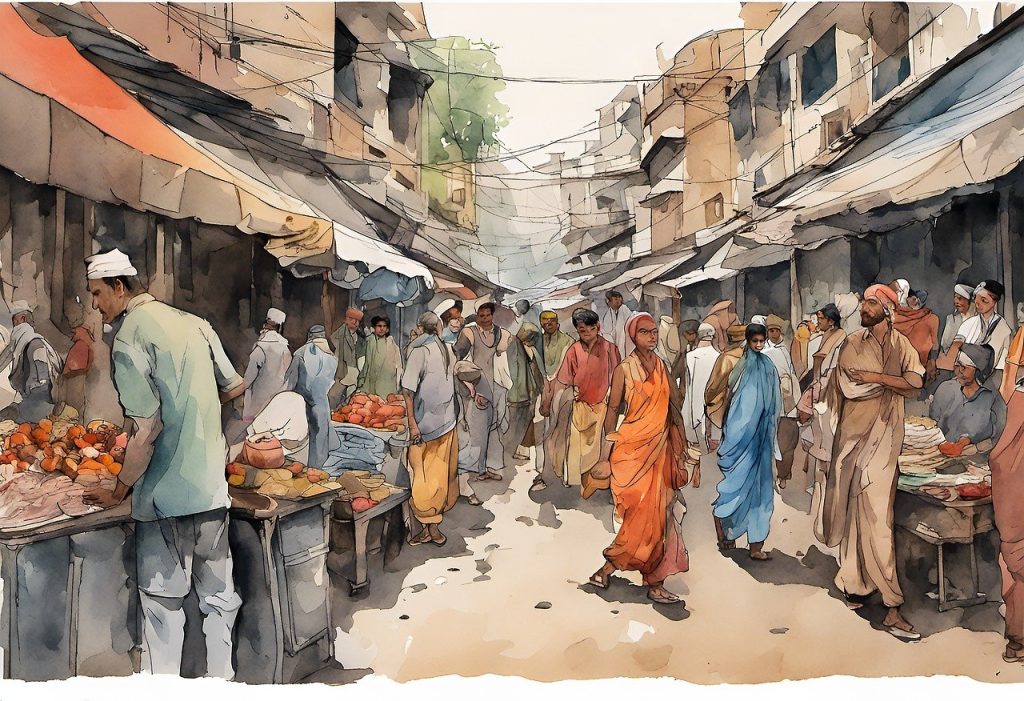You may have observed intricately carved wooden panels adorning the doors and windows of old houses in Punjab and wondered about their origin. These decorative panels, known as Chinioti kunna, provide a glimpse into the craftsmanship of yesteryears and the cultural influences that shaped the region. As you delve deeper into the history of Chinioti kunna, you unravel the fascinating story of the rise and fall of this woodwork art. Initially developed in the 16th century in Chiniot, these wooden panels incorporated motifs inspired by Mughal and Persian architecture with geometric patterns and floral designs. Chinioti kunna reached the pinnacle of popularity in the late 19th and early 20th centuries before facing a gradual decline due to changing architectural styles and economic factors. Though only a remnant of Chinioti kunna artisans and their work remain today, their masterpieces continue to adorn historic buildings, serving as a reminder of the rich artistic heritage of Punjab.Origins of the Chinioti KunnaThe Chinioti Kunna originated in the Chiniot region of Punjab, Pakistan,
where they were first developed in the 17th century. Local artisans began crafting intricate woodwork to decorate the facades of buildings, with geometric patterns and calligraphy that became characteristic of the Chinioti style.As the Mughal Empire declined in the 18th century, many artisans lost their royal patrons and court commissions. Some traveled to find new markets for their craft, settling in cities like Lahore, Multan and Karachi. They brought the Chinioti style with them, using it to decorate havelis, mosques and shrines across Punjab.By the mid-19th century, the Chinioti Kunna had spread throughout British India. The style was used on doors, windows, pillars and archways of public buildings and private homes. Chinioti craftsmen were in high demand, traveling between cities to find work and spreading their distinctive style. The Chinioti Kunna ultimately came to symbolize the finest in traditional woodcarving.However, the Chinioti Kunna began to decline in the early 20th century with the advent of new architectural styles. The intricate woodwork and calligraphy of the Chinioti style were seen as old-fashioned. Commissions dwindled,
and craftsmen struggled to find work. Some Chinioti woodcarvers transitioned to making furniture, but many left the craft.Today, the Chinioti Kunna is celebrated as an integral part of Pakistan’s artistic heritage, though only a few master craftsmen still practice the traditional techniques. Efforts are underway to preserve and revive this historic craft, ensuring that the origins and journey of the Chinioti Kunna are not forgotten.The Golden Age of Chinioti Furniture CraftIf there was a golden age for Chinioti furniture, it would undoubtedly be from the late 19th to mid-20th century. During this time, Chinioti craftsmen produced some of the finest examples of wooden furniture in the Punjabi style.Master Craftsmen and ApprenticeshipsThe level of skill and artistry during this period was unparalleled. Craftsmen went through long apprenticeships, sometimes up to 12 years, to hone their talents before becoming master craftsmen. These masters, known as ‘ustads’, employed and trained apprentices to meet the high demand for Chinioti furniture from aristocrats and the rising middle class.Locally Sourced WoodThe wood of choice was ‘sheesham’, also known as Indian rosewood.
This durable yet beautifully grained wood was sourced locally in the forests surrounding Chiniot. Other woods used included ‘sandal’ and ‘sal’. The wood was carefully selected and seasoned to prevent warping before being transformed into elegant furniture.Ornate and DecorativeThe hallmark of Chinioti furniture was its ornate decoration. Surfaces were hand-carved with intricate floral and geometric patterns. Legs, arms and backs of chairs were shapely and sculpted. Decorative brass fittings, mother-of-pearl inlays and lacquerware accents were also commonly featured. The level of detail and artistry made each piece a showpiece.Sadly, economic and social changes led to a decline in demand for Chinioti furniture by the mid-20th century. While a revival is underway, the golden age of the craft has passed into memory and serves as an inspiration for the future. By understanding this history, we can work to preserve this cultural heritage and support its artisans.Notable Chinioti Furniture MakersThe furniture industry in Chiniot reached its peak during the late 19th and early 20th centuries.
Several renowned furniture makers helped establish Chiniot as a hub for high-quality woodworking and craftsmanship.Haji Muhammad Ishaq and SonsHaji Muhammad Ishaq and his sons were prolific furniture manufacturers, specializing in “Chinioti kunna,” a distinctive angled leg. Their pieces featured intricate wood carvings and metalwork accents. At the peak of their success in the early 1900s, Haji Ishaq and Sons exported furniture throughout British India and had over 200 craftsmen producing high-volume orders.Muhammad Sharif and CompanyMuhammad Sharif learned wood carving from his father, who was a student of Haji Ishaq. He started his own furniture company in the 1920s, creating replicas of Mughal- and British-inspired designs with Chinioti kunna legs. Muhammad Sharif was an early innovator, incorporating mother-of-pearl and brass inlays into his pieces. His company also mass-produced furniture for clients across India,
employing up to 500 workers at its height.Other Notable MakersAdditional craftsmen contributed to Chiniot’s fame, such as Muhammad Bakhsh, whose company operated for over 70 years, and Mian Muhammad Sadiq, who was known for high-quality reproductions of antique styles. Chiniot’s furniture tradition was a family affair, with skills and trade secrets passed down through generations.This golden age of Chinioti furniture unfortunately came to an end following the independence and partition of Pakistan in 1947. However, the city’s historical role in popularizing a unique style of angled furniture leg lives on and serves as an inspiration to modern woodworkers and designers. The Chinioti kunna remains an important part of Pakistan’s artistic heritage.Decline of the Chinioti Furniture IndustryThe decline of the Chinioti furniture industry began in the late 19th century with the introduction of European-inspired furniture designs in British India. The ornate and intricately carved Chinioti style fell out of favor as minimalist Victorian furniture became popular.
Many Chinioti craftsmen struggled with the transition to the new styles.Competition from Machine-Made FurnitureThe early 20th century also saw the rise of mechanized furniture production using steam-powered machines. Furniture could now be mass-produced at a fraction of the cost of handcrafted pieces. Wealthy patrons began preferring this inexpensive, factory-made furniture over the handmade Chinioti craft. The livelihoods of many woodcarvers and other craftsmen were jeopardized as sales declined. Some adapted by simplifying their designs to reduce costs, but many left the trade entirely.Impact of PartitionThe partition of British India in 1947 dealt a major blow to the Chinioti furniture industry. The city of Chiniot became part of Pakistan, while much of the furniture trade had traditionally been centered in northern India. Craftsmen lost access to established trade routes and many long-time clients. Some Hindu craftsmen fled Chiniot altogether during partition,
taking with them generations of woodworking knowledge and skills.DeforestationCenturies of furniture production took a heavy toll on the forests around Chiniot. Many preferred woods like sheesham and teak had been nearly depleted by the mid-20th century. The cost and scarcity of wood made the production of Chinioti furniture less profitable and less practical. Alternative materials did not produce pieces of the same quality.Today only a few craftsmen still produce Chinioti furniture using traditional joinery and carving techniques. Though a shadow of its former glory, the cultural heritage of this artistic tradition lives on in museums and the homes of collectors who continue to value its beauty. With support, the craft may yet experience a revival and reclaim its prestigious place in Pakistan’s artistic history.The Legacy and Revival of Chinioti FurnitureThe Legacy and Revival of Chinioti FurnitureFor centuries, Chiniot was renowned for producing high-quality wood furniture that was exported around the world.
At the height of its popularity in the 19th and early 20th centuries, Chinioti furniture was prized by royal families and aristocrats in India, the Middle East, and Europe. The intricate wood carvings and durable construction made each piece a work of art.Sadly, the Chinioti furniture industry declined in the mid-20th century due to competition from cheaper, mass-produced furniture. Many workshops were forced to close, and the skills required to produce traditional Chinioti furniture were at risk of being lost forever.Fortunately, recent efforts have revived interest in this cultural heritage. Government programs and non-profits have worked to preserve traditional woodworking techniques by training new generations of artisans. Consumers seeking high-quality, eco-friendly furniture have also boosted demand for handcrafted Chinioti pieces
.Some workshops have modernized their designs to appeal to contemporary tastes while still utilizing time-honored construction methods. The bold colors and geometric patterns that were once hallmarks of Chinioti style have been adapted into sleeker, minimalist forms suitable for modern homes and businesses. These fusions of traditional craftsmanship and modern esthetics have introduced Chinioti furniture to new audiences.Though still a niche industry, Chinioti furniture has seen a modest resurgence thanks to those committed to sustaining Punjab’s artistic legacy. Each meticulously hand-carved table, chair, or cabinet serves as a reminder of a storied past even as Chinioti workshops chart a new course into the future. The revival of this cultural treasure is a heartening example of how ancient traditions can be adapted to meet the needs of an evolving world.Chinioti furniture remains a point of pride for Pakistanis and a coveted heirloom around the globe. As long as there are artisans to keep the craft alive and patrons to support them,
the glory days of Chinioti woodwork may yet lie ahead.ConclusionAs you have discovered from this journey into Chinioti Kunna’s storied past, even the grandest of empires eventually fade into memory. Though once a center of culture, trade, and innovation, today little remains of this former metropolis save for ruins and relics. Yet by understanding Chinioti Kunna’s remarkable rise and gradual decline over centuries of change, you have gained insight into a civilization that profoundly shaped the region. While the city may have fallen, its enduring influence lives on. The next time you observe examples of Chinioti art or architecture elsewhere, you can appreciate them all the more deeply, seeing shadows of a long-lost golden age still visible today. Though Chinioti Kunna now exists only in history books, its memory will continue to inspire wonder and connect us to those who walked its bustling streets generations ago.





